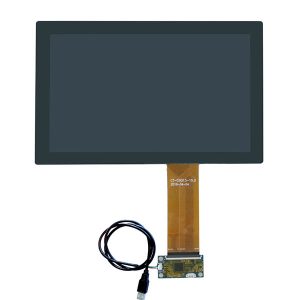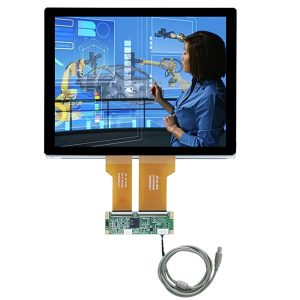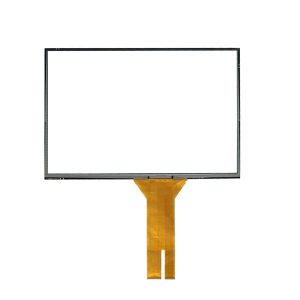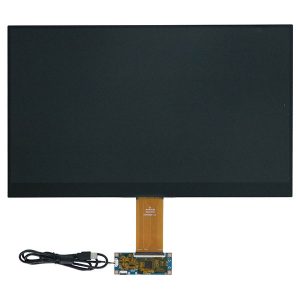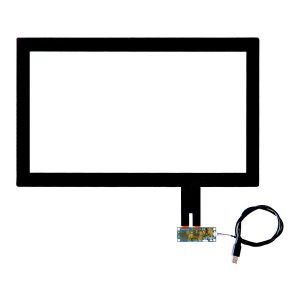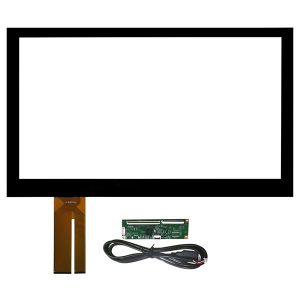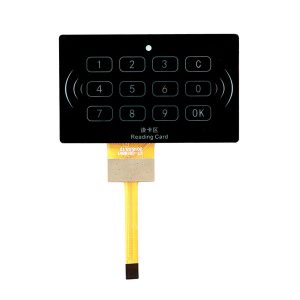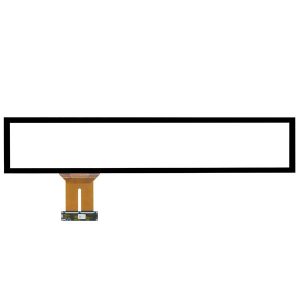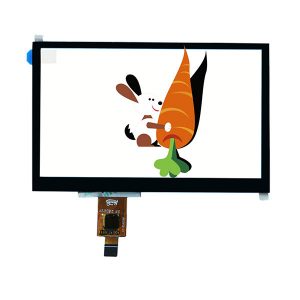What is a resistive touch screen?
A resistive touch screen is a sensor that converts the physical position of a touch point (X, Y) in a rectangular area into a voltage representing an X coordinate and a Y coordinate.
Resistive touch screens was used on many LCD modules, this type of screen can generate bias voltages with four wires, five wires, seven wires or eight wires while detecting the voltage at the touch point.
Structure of Resistive Touch Screen
Resistive touch screen is a kind of sensor, which is constructed basically with film plus glass.
ITO (nano-indium tin oxide) is coated on the connecting surface of both the film and the glass. ITO features good conductivity and transparency.When touched, the ITO under the film will contact the ITO on the upper layer of the glass, corresponding electrical signals will be transmitted through inductor, then sent to the processor via the conversion circuit, .By computing, they will be converted into X and Y attribute on the screen then complete the selection operation and display the result on the screen.
Working Theory of Resistive Touch Screen
Fundation of the theory
The working principle of the resistive touch screen is mainly to access the operation and control of the screen content through the principle of pressure sensing. The part of the screen of the touch screen is very close to the surface of the display.
The operation and control of the resistive trouch screen was accessed mainly by sensing the pressure on the screen.
The screen block is a piece of multi layer composite filme which is very matched.Wherein the first layer is made of glass or plexiglass,the second layer is a barrier layer.While the third layer is a multi resin surface layer. The surface is coated with a transparent conductive layer which covered with another plastic outer layer with hardness processed and slickness and scratch resistance.
The conducting layer and sensor of glass layer on the surface of multi power surface are divided by a plurality of tiny compartments.When the current passing through the surface layer,touch the outer layer slightly, it will access the bottom layer, the controller will read the symmetrical current from the four corners and the calculate the distance of the finger position simultaneously.The touch screen was comprised of two layer highly transparent conductive layers of which the gas between two layers is merely 2.5 mcrons.
When you touch the screen with your finger, a contact occured between the two conductive layers that are normally insulated from each other. One conductive layer turns on the 5V uniform voltage field in the Y-axis direction, leads the voltage of the dedection layer alter from zero to non zero. After the controller detects it’s turn-on, it will perform A/D conversion, and compares the obtained voltage value with 5V to obtain the Y-axis coordinate of the touch point. The coordinates of the X-axis will be obtained on the same way. This is the generaly basic common principle to all resistance technology touch screens.
Circuit implementation
The touch screen includes two transparent layers stacked on top of each other. The four-wire and eight-wire touch screens are composed of two transparent resistive materials having the same surface resistance. The five-wire and seven-wire touch screens are composed of a resistive layer and a conductive layer, besides,usually there will be another elastic material to separate the two layers.
When the pressure on the surface of the touch screen (such as pressing through a pen tip or finger) is large enough, contact between the top layer and the bottom layer will occure. All resistive touch screens use a voltage divider to generate voltages that represent the X and Y coordinates. As shown in Picture 3, the voltage divider is implemented by connecting two resistors in series. The upper resistor (R1) is connected to the positive reference voltage (VREF) and the lower resistor (R2) is connected to ground. The voltage measurement at the junction of the two resistors is proportional to the resistance of the resistor below.
In order to measure a coordinate in a particular direction on a resistive touch screen, we need to biase the resistive layer: connect one side to the VREF and the other sie to the ground.Also, connect the unbiased layer to the high impedance input of an ADC. When the pressure on the touch screen is large enough,contact will occur within the two layers, the resistive surface will be divided into two resistors. Their resistance is proportional to the distance from the touch point to the offset edge. Also,the resistance between the touch point and the ground side is equivalent to the one below the voltage divider. Therefore, the voltage measured on the unbiased layer is proportional to the distance from the touch point to the ground side.
Manufacturing techniques are vital to the ITO conductive film which is coated internally on the resistive touch screen. The coating should not be too thick, otherwise it will not only reduce the light transmittance, but also form an internal reflection layer to reduce the definition. It could not be too thin either, otherwise it will break easily.
The accruacy of the touch screen rely on the precision of the resisitor network during processing. Any fault in the resistance network will lead to a touch failure on the touch screen.Due to that the surface of the touch screen are uesed quite frequently,tiny crack may appear on the conductive film of the thin clear surface layer which will also lead to touch failure.Besides, the outer layer of the transparent ITO conductive film is made of plastic there is no extra protective layer, making the protection is poor.
Due to the unique structure, the resistive touch screen is a comparative closed system which will not be influenced by the external pollutants such as dust, moisture, stain etc.It also applies to any working condition with gloves or hand touch is not available.thus,the resistive touch screen is able to function properly under harsh environments and suitable for the airborne dispaly system.
Classification of Resistive Touch Screen
Four-wire touch screen
The four-wire touch screen contains two resistive layers. One of the layers has a vertical bus on the left and right edges of the screen, and the other layer has a horizontal bus at the bottom and top of the screen, as shown in Picture 1
In order to measure in the X- axis direction, the left bus is biased to OV, and the right bus is biased to VREF. Connect the top or bottom bus to the ADC, when the top and bottom layer touchs each other, a measurement is done.
For the measurement in the Y-axis direction, the top bus is biased to VREF and the bottom bus is biased to OV.Terminating the ADC input to the left or right bus, the voltage will be measured when the top layer touchs the bottom layer.
Picture 2 you shows a simplified model of a four-wire touch screen when the two layrs are in contact.The ideal connection method for a four-wire touch screen is to connect the bus biased to VREF to the positive reference input to the ADC and set the OV to the negative reference input of the ADC.
Five-wire touch screen
There are a resistive layer and a conductive layer on the five-wire touch screen.The conductive layer has a touch spot which usually is located on the edge of one side.While on the conductive layer, a touch spot was distribute on the four corners.Biase the upper left and lower left corner, then ground the upper right and lowe right corners you will ge the measurements of X-axis direction.
The voltage are the same at the left corner and right corner, the result of connecting the bus to left and right side are almost the same. It is similar to the method used in the four-wire touch screen. To get the measurements on Y-axis, you need to offset the upper left and upper right corners to VREF, and biase the lower left and lower right corners to 0V.
Due to the voltage at the left corner and right corner are the same,the result of connecting the bus to the top and bottom edges are substainially the same.It is a similar means to the ones used in the four-wire touch screen. The advantage of this measurement algorithm is that it keeps the voltages in the upper left and lower right corners constant.But if you use grid coordinates, the X and Y axes need to be reversed.
The optimal connecting method for five-wire screen is to access the upper left corner (offset to VREF) to the positive reference input of the ADC and joint the upper left ( offset 0V ) to the input of negative reference of the ADC.
Seven-wire touch screen
The means to implement the seven-wire touch screen is same as the five-line touch screen, except adding one extra wire at the upper left and lower right corner. When measuring, plug the wire on the upper left to VREF and the other wire to the positive reference end of the SAR ADC.
Meanwhile, joint the wire of lower right to 0V and other wire to the negative reference end of SAR ADC. The conductive layer is still utilized to measure the voltage of the voltage divider.
Eight-wire touch screen
The means to implement the seven-wire touch screen is same as the five-line touch screen, except adding one extra wire on each bus. For the bus of VREF, connects one wire to VREF and the other wire will be used as the positive reference input for the digital anolog converter of SAR ADC.
On the bus of 0V, one wire is used to connected the 0V, the other wire is utilized as the negative reference input of digital anolog converter for the SAR ADC. Any of the four wires on the unbiased layer can be used to measure the voltage of the voltage divider.
The advantages and disadvantaes of the Resistive touch screen structure
Advantages
The screen and control system of resistive touch screen is comparatively cheap, while the response sensitivity is very good.
No matter four wire or five wire resistive touch screen, they are in a working environment which is completely isolated. It won’t be influence by the external pollutans such as dust, moisture, stains etc and also suitable for all sorts of demaning environments.It features good stability and can be touched by any object.
A brief summary of the merits of the resistive touch screens:
1. High precision and can reach the pixel level.The maximum resoluation reaches up to 4096 x 4096.
2. Excellent performance,not influenced by dust,moisture and stain. It can be functioned in the environments of both low and high temperature.
3. Easy operation.Resistive touch screens use pressure sensing, which can be touched with any object, even with gloves, and can be used for handwriting recognition.
4. Low cost.Resistive touch screens are less expensive due to mature manufacturing technology and lower barriers.
Disadvantage
The disadvantage is that the outer film of the resistive touch screen is easily scratched and the touch screen is not available, and the multilayer structure causes a large loss of light. For handheld devices, it is often necessary to increase the backlight to compensate for the problem of poor light transmission, but this also Will increase battery consumption.
The disadvantage of the resistive touch screen is that the outer film is apt to get scratched which will result touch failure.Besides,the multi layer structure will cause a large quantity of light loss,thus for the handheld devices, backlight need to be supplemented with the purpose of compensating the problem of poor light transmission.But as a consequence,the battery consumption will be increased.
A brief summary of the shortcoming of the resistive touch screens:
1.Multi touch spot is hard to be made.Resistive touch screen can be designed as multi-touch, but when two points are pressed at the same time, the pressure of the screen becomes unbalanced, resulting in errors in touch.
2.Resistive touch screens are more apt to be broke due to the scratches and other factor.

